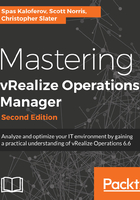
Does size matter?
Doing proper scaling before you go and deploying vRealize Operations is very important.
Scaling in vRealize Operations can be achieved by two methods:
- Scaling vertically by either adding resources or storage
- Scaling horizontally by adding nodes
The resources needed for vRealize Operations depends, on the following factors:
- Size of the environment that you expect to monitor and analyze
- Number of objects that you plan to monitor
- Number of metrics that you plan to collect
As you can see from the following table, VMware offers various sizes during installation, each of which consume a certain amount of CPUs and memory to be able to handle a given amount of objects and collected metrics:

The best approach to addressing sizing is through self-monitoring. Allocate as many objects as possible, but create an alert for a situation where the capacity falls below a particular threshold. The alert must allow enough time to add nodes or disks to the cluster.
You can always initially size vRealize Operations according to the existing environmental monitoring needs. After the vRealize Operations instance is no longer capable to handle the environment/object grown, you must expand the cluster to add nodes of the same size.
For complete sizing guidelines, you can refer to the vRealize Operations 6.6 Sizing Guidelines (KB2150421) article.
Now let’s talk about cluster disk space.
You can calculate the amount of disk space needed for your vRealize Operations installation by using the sizing guidelines spreadsheet. This spreadsheet is available in the VMware knowledge base (KB2150421) article.
In this spreadsheet, you enter the number of VMware vSphere objects of each type: virtual machines, host systems, datastores, and so on.
For objects other than vSphere, VMware suggests that you install the adapter and collect the data for at least an hour. You can then look up the number of objects and metrics that the adapter instance collects and enter them into the spreadsheet.
You can find the number of objects and metrics the cluster collects by navigating to the Cluster Management page in the user interface, as explained before.